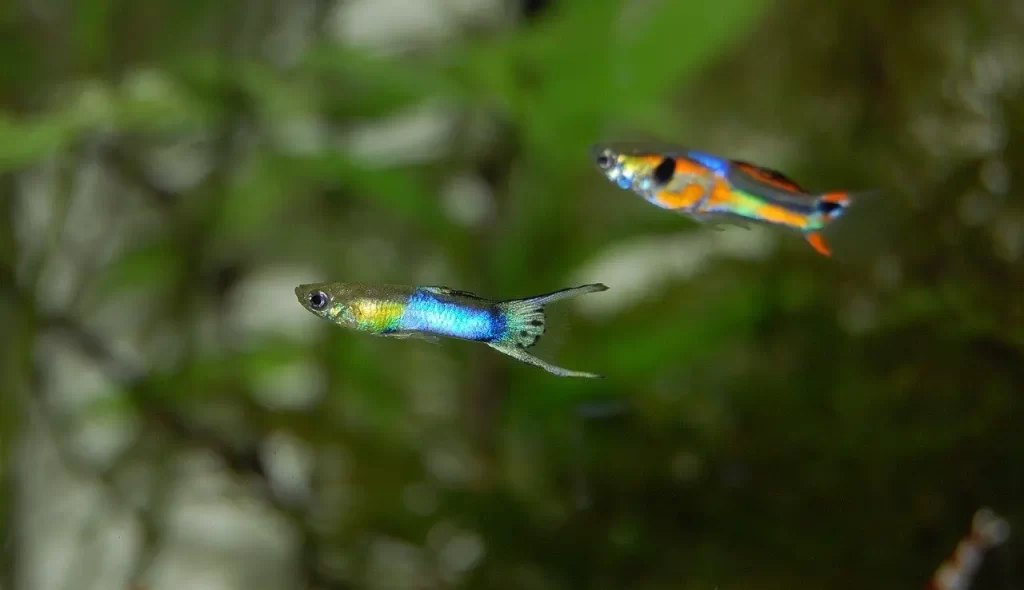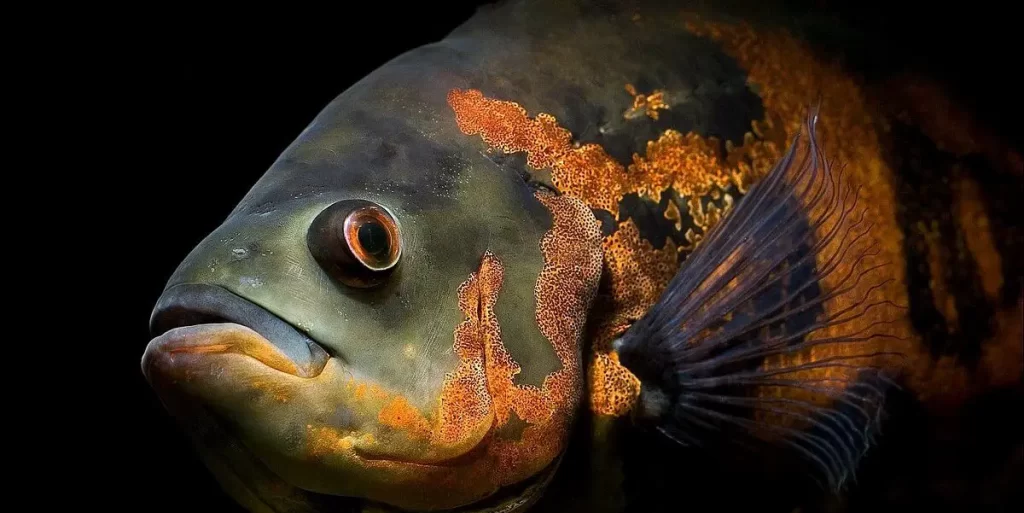When it comes to selecting a fish tank for guppies, there are many options to choose from. Undoubtedly, the 20-gallon fish tank is a minimal yet the best choice for an upgrade to a School from an individual Guppy tank for beginners. If you are wondering how many guppies you can fit in a 20-gallon tank without it being too crowded, then this article is for you!
Though Guppies are hardy fish, they do require a decent-sized aquarium. Let’s assume your tank has decorative items that take up around 4-5 gallons of your tank space. The average size of an adult guppy is 1 inch. So, As 1 inch of fish requires 1 gallon of water, you could place roughly around 14 adult guppies.
However, the number of guppies can vary according to your experience, tank facilities, and the quality of life you can maintain for your guppies. Then let’s get calculating!
Calculate the Number of Guppies for a Fish Tank
We believe you’ve heard about the “one inch of fish per gallon” rule. This rule determines the maximum number of guppies in any aquarium. However, it’s not always the case.
In a 20 gallon aquarium, the amount of water you can add will be less than 20 gallons. It is because of the essential elements in an aquarium:- like the gravel, the internal or sponge filter, the decoration or live plants, as well as the heater; take up space. It turns out your 20-gallon tank will only hold about 16-17 gallons of water.
According to the records, an average adult guppy can reach up to 1 inch, excluding their tail length. This means an adult guppy will need at least 1 inch per gallon of water.
Following the golden rule, in a 20-gallon tank, you can add approximately 14 adult guppies (the logic being: 20-6 gallons/ 1 inch = 14). If you are a beginner, then we don’t recommend having more than 12 guppies in your tank. The same goes for an upgrade because it is always better to start slow.
Can You Add More Guppies into 20 Gallons Aquarium?
Here’s where the “one inch of fish per gallon” rule is applied: Yes, you can add more guppies into your 20-gallon aquarium. The bigger your tank is, it gets easier to maintain. This means that having a crowded population might be easier in a 20-gallon tank. But you need to maintain the quality of life of your guppies. Here are a few things you need to consider:
Upgrading to a good filter
Without a good filter, the aquarium water will become dirty, smelly, discolored, and full of substances that can destroy the ecosystem. Most aquariums, when purchased, come with an internal filter. However, these filters have a specification for how much capacity they are built. Since we want to add more Guppies to the aquarium, the filter that comes with the tank will not be enough to maintain the quality of water. So, you will need to add a much powerful aquarium filter like external filters.
The types of filters are:
Internal Filter: For a better functioning tank, an upgrade to a bigger internal filter is required. Bigger internal filters improve performance with a higher flow rate.
External Filter: Surpassing the internal filter is the investment in a good external filter. Additionally, external filters consist of water in itself hence increasing the volume of water in the tank. External filters come in two types: canister filter, which is bulkier and use tubes, and the hang-on- back filter, which are comparatively smaller and can be hanged.
Another tip is to get a filter that has the capacity for a higher volume tank. This means, if you have a 10-gallon tank, get a 20-gallon filter, and if you have a 20-gallon tank, get a 30-gallon filter.
Getting a strong external filter of 30-gallon capacity will help your stock flow. The Penn Plax Cascade, a 30-gallon canister filter, or the Aqua Clear, a 30-gallon hang-back filter, are our best recommendations.
Addition of a biological filter media to your filter
A biological media consists of colonies that consume ammonia, nitrite, and nitrate, toxins produced by the fish themselves. It is straightforward to use as you can place most bio-filter media directly inside the mechanical filter that you already own.
In addition to the filter upgrade, you will also need a biological filter media. It is essential for an overstocked aquarium to have space for the bacteria to settle on and form stable colonies. Types of biofiltration media include ceramic rings, sponges, pads, bio balls, sand, and gravel, etc.
So, we need to include two filters in an overstocked 20-gallon tank: the sponge filter, being a mechanical filter, and the biofilter media that removes toxins.
Incorporating Live Plants
Adding live plants in your Guppy aquarium increases security for your guppies. Guppies tend to hide around plants since it’s their natural habitat. The toxins produced by fish excretions are absorbed by the plants to grow. They help a lot to improve the quality of the water as well as reduce algae growth.
However, live plants will require nutrients from time to time. For this, consider adding aquarium based plant fertilizer to your tank. It should be enough to keep your plant healthy. Also, keep in mind that plants require light for at least 6-8 hours per day. Therefore, keeping the lights turned on is important to avoid dying and rotting.
Some plants you can use in your 20 gallon Guppy tank are:
Guppy grass
Java ferns
Hornworts
Watersprite
Wisteria
Amazon sword
American waterweed (Elodea)
You can also add flowering plants such as:
Duckweed
Amazon frogbit
Giant duckweed
Water lettuce
Adding/Using Special Substrate
The kind of substrate you use will affect the water chemistry, filtration, and the well-being of your tank’s ecosystem.
Gravel is the most commonly used substrate that contributes much to the aquarium’s aesthetic appeal. It is budget-friendly as well. But gravel consumes space and requires vacuum cleaning (during water changes). Sand is also a good option for bottom dwellers like Guppies.
A variety of substrates are available in the market like gravel, sand, dirt, crushed marble, or artificial substrate. You can also find ones that self-cleans, can clean bacteria, and even breakdown fish wastes.
Keeping the Feeding Rate Minimal
You can feed your Guppies a variety of frozen/dried foods like; brine shrimp, bloodworms, or even daphnia. These foods will maintain balance, variety, and create a healthy environment.
The optimal feeding time for your Guppies is each alternative day. Guppies can stay without eating for a long time, but they always tend to be hungry.
One thing to ensure while feeding any fish is adding only a small quantity at once. This will ensure that guppies eat all its food, and there are no leftovers. Try not to overfeed your guppies.
Regular Maintenance & Water Changes
An overstocked aquarium requires a dedicated water change regime. How often you’ll need to change your water will depend on a lot of factors like the number of Guppies, how messy the guppies are, and the ammonia processing capacity of your filter.
Cleaning the water and filter once a week at the rate of 25-30% with a quality filter and media should be enough. This ensures that your tank stays clean and free from bacteria and algae.
A point to note is never to use tap water to clean filters because the water is chlorinated. Dechlorinate the water during water changes and also remember to vacuum the bottom of the tank.
Can I Add Other Fish to my 20-Gallon Guppy Tank?
Guppies are social and versatile in nature. They prefer to be accompanied by fish rather than being alone, be it the same breed or another breed.
The answer to this question is yes! Yes, you can keep non-aggressive, peaceful fish in your tank along with your Guppies. Some common compatible fish are swordtail, platy, neon tetras, mollies, algae eaters, cory catfish, and bettas. Similar living conditions of fish also play a vital role in including different breeds.
If you keep aggressive fish in your tank, then it is likely that your guppy will be injured, which can cause infections and diseases. This will inevitably cause stress and can affect its health.
Here is the full article on Guppy Disease and Treatment.
However, Bettas, a semi-aggressive fish, are much more compatible with the Guppy fish in a ratio of 4:1. It is a good idea to opt for two breeds of bettas: Halfmoon Betta fish and the delta Betta fish.
Can a 20-gallon tank be used for mating?
A 20-gallon tank is a perfect environment for mating Guppies. After placing the male and the female, you will know if the female is pregnant by a dark mark on her abdomen.
Guppies are livebearer fish that can produce offspring in a copious manner. They can exhibit cannibalism after birth. Therefore, it is important to keep plants in the tank for your fry to hide. We recommend separating the parent from the fries after birth while ensuring the filter is covered with a sponge.
Other tank conditions
Some of the conditions you need to maintain in your tank are:
| Category | Condition |
| pH balance | Ideal 7.0 and 7.2 |
| Water hardness | 8-12 |
| Compatibility | Peaceful, community fish |
| Tank Set-Up | Freshwater plants, substrate |
Conclusion
With bigger goals, comes bigger responsibility. Upgrading to a 20-gallon school for Guppies might not be an easy task. It is important to maintain the ecosystem and be passionate about doing so.
But by following the tasks as mentioned above, we hope you find how many guppies you can place in your 20-gallon tank.






